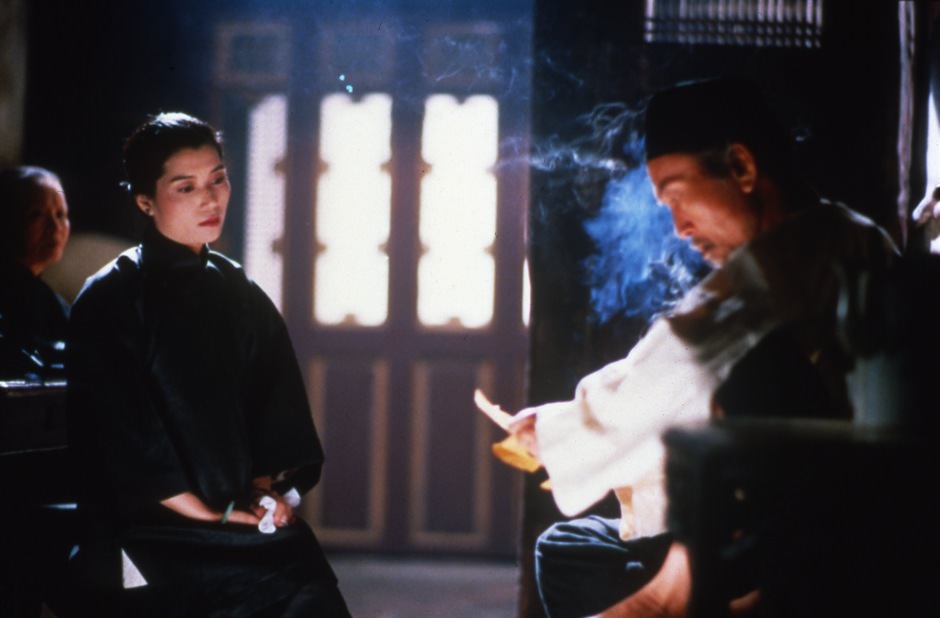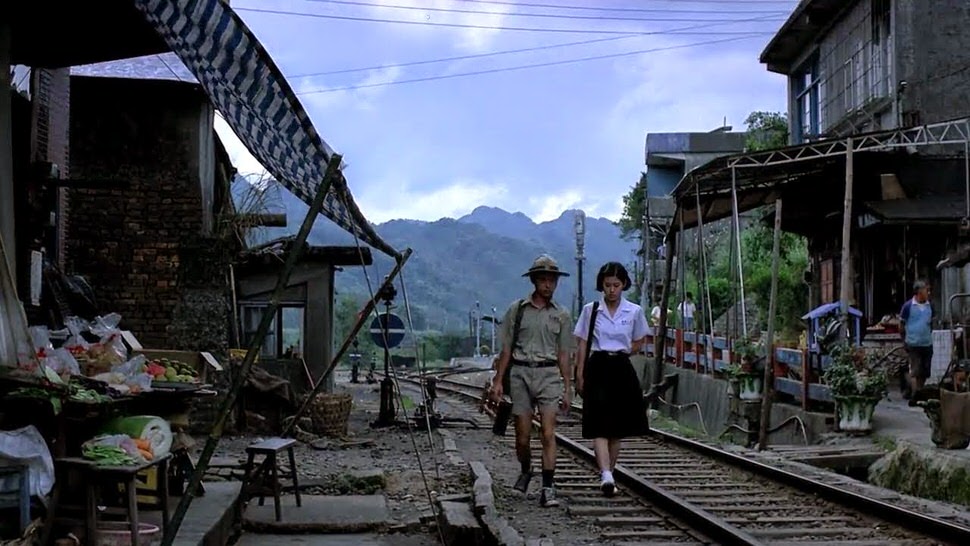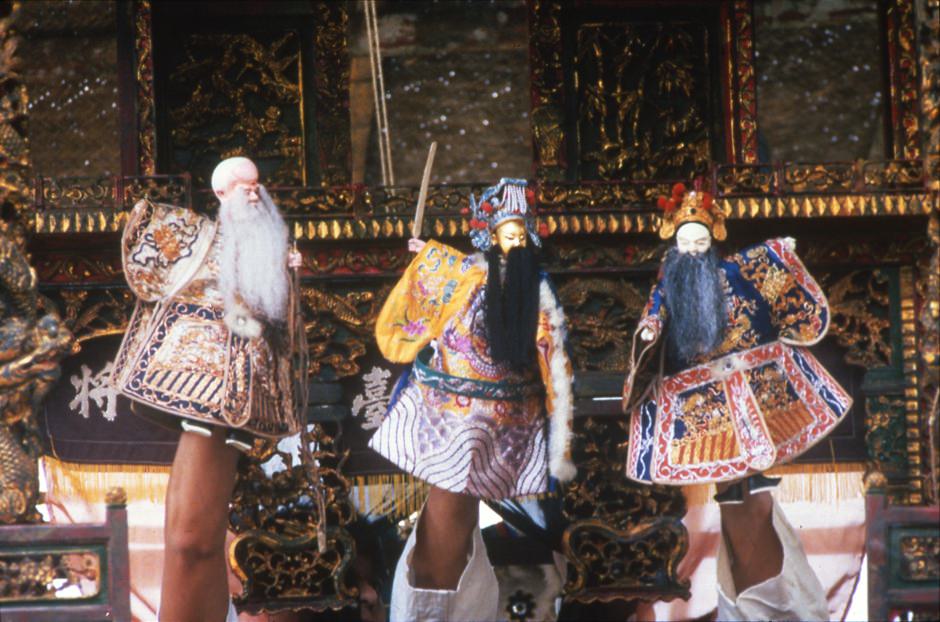Although the Taiwanese director Hou Hsiao-hsien has been making movies since the early 1980s, I first became convinced of his genius when I saw The Puppetmaster (1993) some twenty years ago. Until then I thought of Hou as the maker of extraordinarily fine, essentially contemplative, quasi-autobiographical youth films—my favorites were Dust in the Wind (1986) and Daughter of the Nile (1987), both of which impressed me with their evocation of the ephemeral, their haunting sense of solitude, and the eloquence with which they left things unsaid. The Puppetmaster went much further, demonstrating a profound and original sense of motion pictures as a way of exploring the passage of time.
Like most of Hou’s films, The Puppetmaster was never commercially released in the United States and has been rarely screened. It is an event to have it anchoring the comprehensive Hou Hsiao-Hsien retrospective now showing at the Museum of the Moving Image in New York, which will continue on a North American tour to cinematheques and museums in Cambridge, Berkeley, Washington, D.C., Rochester, Toronto, Vancouver, Houston, and Chicago.
This epic chamber-piece, which split the Jury Prize at Cannes in 1993, is neither documentary nor fiction. (The Chinese title is “Drama, Dream, Life.”) The movie dramatizes the youth and early career of Taiwanese “national treasure” Li Tien-lu who, born in 1910, became an apprentice puppeteer at age eight, performing traditional plays first in remote mountain villages and later for Japanese officials in Tapei. During the war these shows became morale-building propaganda, dramatizing combat against American forces, complete with puppet airplanes and smoky special effects. Even in peacetime, though, Japan was a presence. Li’s story, one of continuous family turmoil, is played out during the fifty-year period during which Taiwan was a Japanese colony, from 1895 to the end of World War II. He is one protagonist and history is the other.
Eighty-four when The Puppetmaster was made, Li was for Hou “a living encyclopedia of Chinese tradition” and the film is a comparable anthology of the various ways a story can be told. There are a half-dozen theatrical performances of various types, from puppet shows to Taiwanese opera—usually shown head-on, some in a single long take, and at times revealing the young Li (played by Lim Giong) and his colleagues working behind the stage. These, and panoramic shots of rural Taiwan punctuate the ongoing melodrama of the young Li’s motherless upbringing—one that, among other things, involves child abuse and drug addictions—and later, his own life as an absentee father. Intermittently, there are shots of the octogenarian Li himself recounting his own life.
Presenting these disparate elements in stately alteration, Hou manages to sustain an interplay between Li’s biography, the impersonal social forces around him, and the implacable movement of time. A long sequence around a kitchen table introducing the prostitute who becomes Li’s mistress is followed by a shot in which she is having a her portrait taken, a close-up of the photograph, and then a return to the kitchen table where the photo is being examined with old Li’s voice-over picking up the story.
The Puppetmaster was one of several films in which Hou mixed historical material with a daringly counterintuitive, even oblique, narrative structure. City of Sadness (1989) is an “autobiography” set during the filmmaker’s infancy that uses shifting points of view to recount the postwar occupation of Taiwan by Chinese Nationalists. Based on historical personages, Good Men, Good Women (1995) uses the making a movie to exhume the tragic fate of Taiwan’s progressive intellectuals during the “White Terror” forty years earlier. Goodbye South, Goodbye (1996) is a tale of petty gangsters predicated on long stretches of emptiness—a landscape without a landscape, a road film that goes nowhere.
Flowers of Shanghai (1998), the first of Hou’s film to be set outside Taiwan, adapted from Han Bangqing’s Sing Song Girls, a novel some consider the greatest work of nineteenth-century Chinese fiction, consists of only forty shots, none of which are exteriors even though the book itself is much concerned with the texture of China’s first modern city. For Hou, it is the text that is being documented. In this case, he suggests, the historical moment and the place in which it takes place is beyond our reach.
Taiwan’s half-century as a Japanese colony was time enough for many aesthetic concepts to lodge in the island’s consciousness, and the earliest films in which Hou found his style (The Boys from Fengkuei, 1983, and A Summer at Grandpa’s, 1984) have a reserved Japanese flavor. But Hou only discovered the Japanese master Yasujiro Ozu, so known for his seemingly detached family dramas, well after he began making movies. Hou has his own way of looking. Café Lumiere (2003) which was shot in Tokyo and dedicated to Ozu, is something like Ozu in reverse—rather than a story punctuated by static “pillow shots,” it is a succession of pillow shots with brief narrative interludes.
Advertisement
Rarely using close-ups, Hou is a master of camera placement who frequently shoots an entire scene from a single point of view. Although his characteristic locations—courtyards in Goodbye South, Goodbye, kitchens in City of Sadness and Daughter of the Nile, nightclubs in Millennium Mambo (2001)— tend toward the mundane, his sense of the world is exalted. As much as they are anything else, these deeply melancholy movies are beautiful objects of contemplation.
When I interviewed Hou many years ago in Tapei we met at his preferred spot, a Japanese style teahouse—a marked contrast to the “Chicago-style” burger joint chosen by Hou’s leading contemporary Edward Yang. Unlike the gregarious Yang, whose masterpiece A Brighter Summer Day (1991) concerns Taiwan’s “American” period, immersed in high school turf wars and imported Elvis worship, Hou was reserved and modest, preferring to speak through a translator although he clearly understood English. He disliked travel, he told me, and was critical of Taiwanese investors who, rather than support Taiwanese films, preferred to put their money in Hong Kong or mainland productions: “It’s typical. People don’t value their roots here.” Rather than talk movies, he preferred to explain the history of Cold War Taiwan.
Hou himself was the child of parents who left mainland China for Taiwan when he was a baby in 1948, and died while he was in his teens. Perhaps as a result, he once called Taiwan a “temporary country,” and has made homelessness his great subject—although I can’t think of another filmmaker whose movies feature so many family meals or scenes set around the kitchen table.
His assured, innovative filmmaking is additionally impressive in that he came to film through Taiwan’s commercial cinema. Hou grew up in rural Fengshan, a tropical region along the island’s southwest coast. After completing his two years of military service, he studied film and drama at the Taiwan Academy of the Arts and, following a stint selling electronic calculators, became an apprentice with the Central Motion Picture Corporation. His first two films, Cute Girl (1980) and Cheerful Wind (1981), were conventional vehicles for local pop stars; his third feature, The Green, Green Grass of Home (1982), was named for a song made famous by Tom Jones. He thereafter made a series of films drawing on his own youth or that of his collaborators, movies characterized by their historical consciousness and pervasive sense of loss. (He was also the first Taiwanese filmmaker to use the island’s indigenous dialect.)
Hou’s mature work has an understated rigor. Once he devises the rules for a particular movie, he’s extremely rigorous although those rules are often not immediately apparent: Three Times (2005) presents the same romantic couple in a succession of psychologically fraught settings and historically charged situations. (The first time I saw it, the movie seemed to fall apart in its final movement. But, on second viewing, that disintegration seemed a carefully edited contrivance—such is Hou’s inventive use of time.)
In a certain sense, Hou is an artist out of time—a reminder of our belatedness more than his. When Flight of the Red Balloon (2007) opened here in 2008, I began my Village Voice review with the unprovable assertion that if the director were French, he’d be far more appreciated. Flight of the Red Balloon was in a way a French movie, shot in Paris (it even played at the Paris Theater in New York) but I should have written, “if Hou were French and we were still living in 1974.” His presence signifies the end of a particular era in film culture that ended long ago.
Hou is a postscript to the cluster of European and Asian directors who defined international cinema during the 1950s and 1960s and whose movies were during the heyday of revival theaters frequently available. On the one hand, he is a great formalist, like Michelangelo Antonioni and Robert Bresson; on the other, he brought a hitherto unknown national cinema to international attention, as did Andrzej Wajda with Poland, Akira Kurosawa with Japan, and Satyajit Ray with India. (The only figure who was both was the insufficiently appreciated Hungarian master Miklós Jancsó.) As Hou’s temporal constructions are is as sophisticated as those of Alain Resnais or Chris Marker, there is also perhaps a bit of bewilderment in encountering modernist sensibility in an unexpected setting—or rather in discovering an unexpected, self-invented modernism.
It was for The Puppetmaster that Hou first developed a startlingly advanced form of montage that has been compared to the movement of clouds drifting across the sky. Narrative coalesces and dissipates; dramas merge and comment on each other, not least from the perspective of fifty years later. At a certain point, every cut comes as a surprise, spanning perhaps a dozen years even as the voiceover loops over and around the scene to knot the story with an invisible thread. Is there another filmmaker who can so fluidly celebrate the moment as well as the epoch, and do so in the same shot?
Advertisement
A comprehensive retrospective of Hou Hsiao-hsien’s work, “Also Like Life: The Films of Hou Hsiao-hsien,” is showing at the Museum of the Moving Image in New York through October 17. It will continue to other cities including Cambridge, Berkeley, Washington, D.C., Rochester, Toronto, Vancouver, Houston, and Chicago.





